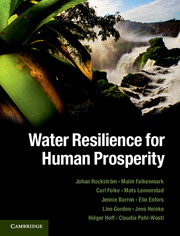Book contents
- Frontmatter
- Contents
- List of Contributors
- Preface
- Introduction to the book
- Acknowledgements
- Part I A new perspective
- Part II Living in a human-dominated world
- Part III Food production globally: in hotspot regions and in the landscape
- Part IV Governance and pathways
- 8 Governance for navigating the novel freshwater dynamics of the Anthropocene
- 9 Pathways to the future
- Glossary
- Index
- References
9 - Pathways to the future
from Part IV - Governance and pathways
Published online by Cambridge University Press: 05 August 2014
- Frontmatter
- Contents
- List of Contributors
- Preface
- Introduction to the book
- Acknowledgements
- Part I A new perspective
- Part II Living in a human-dominated world
- Part III Food production globally: in hotspot regions and in the landscape
- Part IV Governance and pathways
- 8 Governance for navigating the novel freshwater dynamics of the Anthropocene
- 9 Pathways to the future
- Glossary
- Index
- References
Summary
This chapter summarises the role of water in achieving global sustainability and human prosperity on an increasingly crowded planet – characterised by rising interdependence, turbulence, social–ecological interactions and uncertainty. Of particular concern is the increased likelihood of human-induced water-related tipping points in local and regional environments and even in the Earth System as a whole. These often surprising events are reflections of the loss of social–ecological resilience for dealing with change, and could have severe implications for societies and human well-being. The chapter addresses the shifts in governance and management cultures required of strategies for water resilience, and stresses that freshwater is the key to resilience in social–ecological systems. Maintaining redundancy in landscapes through a high degree of biodiversity and a rich mosaic of different land-use types is a key strategy for building resilience and sustaining rainfall and the ‘wetness’ of landscapes.
Bloodstream management
Key messages and building blocks
This chapter addresses these challenges in integrating the different streams of analysis contained in this volume – from the social–ecological pressures on the planet to the IWRM practices available to communities across the world to improve land and water management. It attempts to weave together a ‘waterway forward’ for integrated land and water resource management in the new Anthropocene era. It does so within the framework of the two key messages of the book. First, that human development and wealth originates from social–ecological systems, which all require freshwater for their ability to generate ecosystem functions and services, and to provide social–ecological resilience. From this follows that misuse of freshwater resources challenges not only human well-being, but also social–ecological resilience and the capacity of societies to deal with change, persist and continue to develop.
- Type
- Chapter
- Information
- Water Resilience for Human Prosperity , pp. 250 - 276Publisher: Cambridge University PressPrint publication year: 2014



